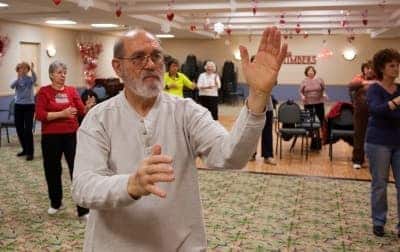
After a frustrating day of dealing with rude shoppers, Eleanor Keagle, 76, of Joliet, stomped into her home and threw down her coat and purse.
Still boiling, Keagle remembered a better way to deal with her anger. So she turned on a CD of soft music and practiced tai chi for one hour.
“It freed my mind and body,” Keagle said.
Keagle has been a tai chi student of Roger Thompson of Joliet ever since he began teaching at The Timbers of Shorewood seven years ago. Thompson uses a yang form and temple style of the Chinese martial art tai chi, which focuses on relaxation, meditation and improving coordination and balance.
“It’s cessation in motion,” Thompson said. “Its benefit is that you can get into a meditative place, which relaxes you. Then your mind and body can work together.”
Longtime interest
Thompson first became interested in tai chi 25 years ago, when he belonged to a bike club and a fellow member commented that his winter warm-up exercises resembled tai chi movements. Intrigued, Thompson read some books, took come classes and practiced its art.
As Thompson grew in knowledge and proficiency, he wanted to share both with other students. So he approached his instructor at the Park District of Oak Park about helping out in the classroom.
“My instructor told me he was actually planning on leaving town,” Thompson said. “So he said, ‘Have at it.’”
From there, Thompson adapted his program into a senior-friendly one and began offering classes at Oak Park Arms retirement community. As Thompson prepared to move to Joliet, he learned that Oak Park Arms had a sister retirement community, The Timbers of Shorewood.
Thompson’s average class size ranges from five to 13 people, from age 52 up to 90. Some students come once or only occasionally. Others, like Keagle, have regularly attended since the class began. One student is both deaf and blind.
The only requirements are willingness to learn, comfortable clothing and perhaps the ability to stand, since many of the movements are done from that position. However, individuals confined to wheelchairs may profit from the sitting routines.
Regular attendance is encouraged for optimal benefits, although Thompson did structure The Timbers class for the more casual participants. Thompson admits that some of tai chi’s benefits can be obtained from other sources, such as yoga and prayer, although he feels tai chi is the most optimal source.
“Brain scans performed on Tibetan monks during meditation showed that a lot was going on in there,” Thompson said. “People used to think we only use a small part of our brain, but we actually use a great deal.”
Relaxation techniques
Many of the postures involve turning from side to side, which promotes relaxation, Thompson said. Each movement proceeds from the core. The limbs are simply extensions of that core. However, students should not closely monitor their movements.
“If you concentrate too much on the experience, on what you’re supposed to be doing, then you’ll lose the meditative quality,” Thompson said. “Our conscious mind gets us away from the bear and the lion, but it doesn’t coordinate our experiences. That’s why, when we have to make an important decision, we say, ‘I’ll sleep on it,’ because we let our subconscious do it for us. The subconscious is extremely powerful.”
For Keagle, tai chi is so relaxing, it’s an effective sleep inducer. When insomnia plagues her, Keagle will slide on her slippers and practice tai chi under the moonlight in the privacy of her fenced back yard. Because she has no music out there, she draws from her happiest memory, her 1994 Hawaii vacation.
“I was standing on a cliff and all I could see was the sandy beach, the water and the clouds in the sky,” Keagle said. “I was so enthralled and at peace that I felt really close to God. So when I’m having a really hectic day, I practice tai chi and I put myself back on that cliff.”
By Denise Baran-Unland
Joliet Herald News – February 13 2013

